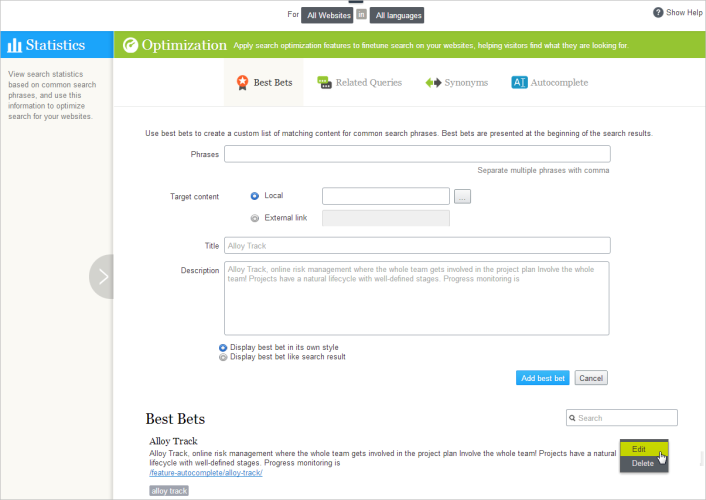 Manually optimizing search results
Manually optimizing search results
Although Episerver Search & Navigation automatically optimizes the search, you should monitor your site's search activities regularly to fine-tune performance and identify trends. At times, you may want to override system suggestions or promote specific content.
When you perform search optimization, work closely with stakeholders such as the website owner, marketers, content editors, and developers. Tasks depend on whether the site is new or mature because of the amount of statistics with which you have to work.
You can perform search optimization for multiple websites and different languages from the same user interface. To optimize search effectively, you must be familiar with your website content.
You need specific access rights to access Episerver Search & Navigation features.
The optimization view
To access Optimization View, from the toolbar, click Search & Navigation > Manage > Optimization.
Use Optimization View to manually optimize search. You can select search phrasesOne or more words that a user enters into a search box to begin a search. in the Statistics view, and transfer them to Optimization View. Or, you can manually enter search phrases into Optimization View's Phrases field.
What to look for
- Frequently-searched phrases indicate "hot" topics, content that visitors assume is on your website.
- Search phrases without hits reveal content missing from your website or a need to improve a content item's ranking in search results.
- If visitors search for content that is related to but not stored on your website, consider adding a connector to index an external website.
- Search phrases with low click-through rates may indicate that the content description is insufficient, or that the title or description is not attractive enough. In the latter case, create a best bet with a custom title and description to promote the content.
- By clicking a search phrase in the list, you see other phrases that the same visitor searched for. For example, if someone searching for project plans also searched for planning and tracking projects, respond by adding missing content, or creating synonyms or best bets for these phrases.
Using the Statistics View data, try the following content optimization tasks.
